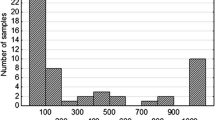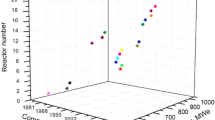Abstract
An efficient natural bioextractant, orange peel extractant, was applied to recover uranium as one of hazardous elements. Batch experiments were carried out to determine the effect of various factors on the uranium extraction using a synthetic standard solution. These factors include the diluent type, pH, solvent concentration, contact time, and temperature. Under the optimum conditions (pH 4, A/O = 3/1), the maximum saturation capacity of the orange peel extractant for uranium reaches approximately 54.5 mg/g. The extracted uranium ions were almost completely eluted with NaCl/H2SO4 (1 M each). The procedure was applied to real sulfate leach liquor of a clay stone sample from Southeastern Sinai, Egypt.


Similar content being viewed by others
REFERENCES
Matheickal, J.T., Yu, Q., and Woodburn, G.M., Water Res., 1999, vol. 33, pp. 335−342. https://doi.org/10.1016/S0043-1354(98)00237-1
Mahmoud, M.A., J. Chem. Eng. Process. Technol., 2013, pp. 4–6. https://doi.org/10.4172/2157-7048.1000169
Moronkola, B.A., Giwa-Ajeniya, A.O., Alegbe, M.J., Eshilokun, A.O., Awokoya, K.N., and Okoh, O.O., J. Org. Inorg. Chem., 2016, vol. 2, pp. 1–6. https://doi.org/10.21767/2472-1123.100013
Imran, A., Mohd, A., and Khan, T.A., J. Environ. Manag., 2012, vol. 113, pp. 170–183. https://doi.org/10.1016/j.jenvman.2012.08.028
El-Mesallamy, A.M., El-Sheikh, E.M., Manaa, E.M., and El-Maksoud, M., Int. J. Adv. Res., 2015, vol. 3, no. 11, pp. 50–65. https://www.researchgate.net/publication/317605093.
Lucks, C., Rossberg, A., Tsushima, S., Foerstendorf, H., Scheinost, A.C., and Bernhard, G., Inorg. Chem., 2012, vol. 51, no. 22, pp. 12288–12300. https://doi.org/10.1021/ic301565p
Bismondo, A., Cassol, A., Di Bernardo, P., Magon, L., and Tomat, G., Inorg. Nucl. Chem. Lett., 1981, vol. 17, nos. 3−4, pp. 79−81. https://doi.org/10.1016/0020-1650(81)80031-1
Rawat, N., Tomar, B.S., and Manchanda, V.K., J. Chem. Thermodyn., 2011, vol. 43, no. 7, pp. 1023−1027. https://doi.org/10.1016/j.jct.2011.02.007
Shahandeh, H. and Hossner, L.R., Water Air Soil Pollut., 2002, vol. 141, pp. 165–180. https://doi.org/10.1023/A:1021346828490
Lauria, D.C., Almeida, R.M.R., and Sracek, O., Brazil. Environ Geol., 2004, vol. 47, pp. 11–19. https://doi.org/10.1007/s00254-004-1121-1
Véra-Tome, F., Rodriguez, P.B., and Lozano, C.J., Sci. Total Environ., 2008, vol. 393, pp. 351–357. https://doi.org/10.1016/j.scitotenv.2008.01.013
Véra-Tome, F., Rodriguez, P.B., and Lozano, J.C., Chemosphere, 2009, vol. 74, pp. 293–300. https://doi.org/10.1016/j.chemosphere.2008.09.002
Ebbs, S.D., Brady, D.J., and Kochian, L.V., J. Exp. Botany, 1998, vol. 49, no. 324, pp. 1183–1190. https://doi.org/10.1093/jxb/49.324.1183
Straczek, A., Duquene, L., Wegrzynek, D., Chinea-Cano, E., Wannijn, J., Navez, J., and Vandenhovea, H., J. Environ. Radioact., 2010, vol. 101, pp. 258–266. https://doi.org/10.1016/j.jenvrad.2009.11.011
Dufey, J.E., Genon, J.G., Jaillard, B., Calba, H., Rufyikiri, G., and Delvaux, B., Fate of Trace Elements in the Rhizosphere, Gobran, G.R., Wenzel, W.W., and Lombi, E., Eds., Boca Raton, Florida: CRC, 2001.
Mathew, K.J., Bürger, S., Vogt, S., Mason, P., Morales-Arteaga, M.E., and Narayanan, U.I., J. Radioanal. Nucl. Chem., 2009, vol. 282, no. 3, pp. 939–944. https://doi.org/10.1007/s10967-009-0186-4
Shapiro, L. and Brannock, N.W., US Geol. Surv. Bull., 1962, vol. 114A, p. 65. https://researchgate.net/publication/302558799.
Sciban, M., Kalasnja, M., and Skrbic, B., J. Hazard. Mater., 2006, vol. 136, no. 2, pp. 266–271.
Gaikwad, R.W., Agric. Food Chem., 2004, vol. 3, no. 4, pp. 702–709.
El-Sheikh, E.M., El Aassy, I.E., Abdel-Rahman, A.H., Ayad, M.I., Fathy, W.M., Taha, M.N., and Kassab, W.A., Int. J. Adv. Res., 2017, vol. 5, no. 12, pp. 1445–1459. https://doi.org/10.21474/IJAR01/6105
Author information
Authors and Affiliations
Corresponding author
Ethics declarations
The authors state that they have no conflict of interest.
Rights and permissions
About this article
Cite this article
Abdelhakim, A.M., Mohamed, I.R., Awad, E.A.M. et al. Recovery of Uranium from Sulfate Leach Liquor Using Natural Orange Peel Extractant. Radiochemistry 63, 316–324 (2021). https://doi.org/10.1134/S1066362221030097
Received:
Revised:
Accepted:
Published:
Issue Date:
DOI: https://doi.org/10.1134/S1066362221030097




